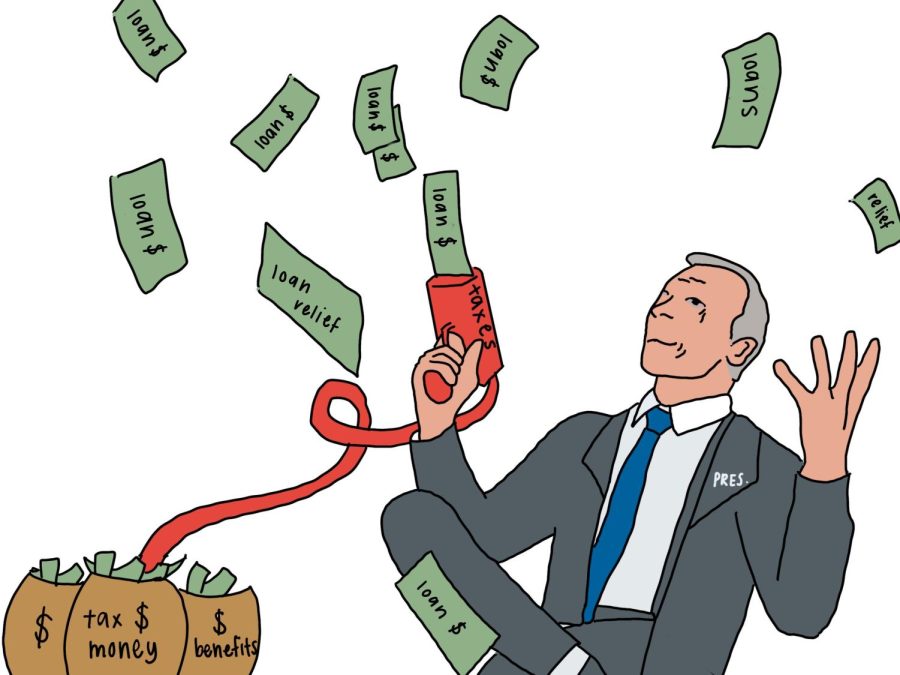Biden’s Student Loan Forgiveness Fails to Meet Even Liberal Criterion
Biden’s loan forgiveness plan, introduced August 24, provides benefits that will undoubtedly benefit struggling workers. However, the funds required to pay for this action are greatly overlooked — a potential $1 trillion will come from taxpayer’s wallets, according to the University of Pennsylvania’s Wharton Budget Model, a nonpartisan research initiative that analyzes the economic impact of fiscal policy.
On August 24, the White House announced its new three-part plan to combat the colossal levels of student loan debt. Depending on a multitude of factors, including individual income and household income, those who qualify for relief could receive anywhere from $10,000 to $20,000 in student loan forgiveness.
With student debt approaching $3 trillion by 2035, according to the Consumer News and Business Channel, it is evident that students are in greater demand for financial aid. However, it has become apparent that Biden’s plan has major faults that will only perpetuate the increasing costs of higher education.
There are three major liabilities: the action is fundamentally unfair, harms Americans in the long run by ramping up tuition costs, and fails to address the root causes of towering student loan debt.
The proposition’s inequities are best explained by the numbers. Projections from the University of Pennsylvania’s Wharton Budget Model state that student debt cancellation alone will cost up to $519 billion, and other measures including loan forbearance and income-driven repayment plans (IDRs) could cost up to $540 billion, thereby raising the total cost to over $1 trillion.
Mirroring these high costs, new estimates from the National Taxpayers Union predict the average burden per U.S. taxpayer will be anywhere from $2,000 to $2,500 in the next ten years. These increased taxes will have even larger impacts on lower-income households who have not pursued a college education.
Ultimately, taking out a loan is a personal responsibility that should not be supplanted by taxpayer bailouts. Holding borrowers accountable for their personal decisions is necessary, and people are not entitled to a college education paid for by others.
Furthermore, less than 15 percent of Americans possess any student loan debt. Is it really fair to offer relief to those who have overstretched their spending capabilities at the expense of others?
Even financially responsible families that have frugally saved every penny to send their children to college may be the ones bearing the costs, as all Americans regardless of income will be taxed. Yet at the same time, a Harvard graduate going to work on Wall Street with a six-figure salary may be the one receiving a hefty $10,000 toward their loan payoff.
Additionally, the revamping of income-driven repayment has high potential for increasing the costs of higher education. Under the new system, borrowers will now pay just five percent of their income for undergraduate loans and 10 percent for postgraduate loans for a period of 10 or 20 years after taking out their initial loan, compared to the previous 10-20 percent.
After the five-to-ten-year period, the remainder of borrowers’ loans will be forgiven. In turn, institutions will be greatly incentivized to charge higher tuition because colleges will no longer be worried about borrowers failing to make payments. Schools such as Georgetown that utilize Loan Repayment Assistance Programs, an IDR alternative only available at the graduate level, have already increased their tuition to further profit off students.
Finally, students will face moral hazards from debt cancellation. Loan relief today offers the realistic hope of loan relief tomorrow. Why would a borrower pay down debt if the government could spontaneously cancel it? Could a student take a potentially irresponsible loan out of hope that the government could assist them? Issues like these only exacerbate the problems with less conservative borrowing.
Students drowning in thousands of unpayable debt is a real concern, yet this begs the question: if one cannot afford a private four-year college that asks for insurmountable sums of money, why attend when there are more sound options?
State and community colleges provide substantially lower tuition that comes with great transfer options, networking, and degrees. Before borrowing money, it is imperative that young Americans consider their current financial situations and future professions before taking on such a large responsibility.
Proponents of Biden’s plan also overlook the stark returns on higher education. The media often portrays borrowers as economically disadvantaged, but a 2019 survey of consumer finances, conducted by the Federal Reserve, found that the top 40% of earners in America held over 70% of all student loan debt.
National Economics Challenge state finalist and junior Atharv Joshi further elaborates on how relieving this debt only distances lawmakers from their political desires.
“In general, [conservatives] try to seek lower tax burdens on American taxpayers, especially the rich, and liberals try to seek more equitable solutions to society,” Joshi said. “Quite frankly, I don’t know if this student loan forgiveness plan meets either of those criteria because you’re not really fully pursuing equality.”
Biden’s solution encompasses this sentiment perfectly, as it only acts as a temporary bandage for a much larger wound. An exorbitant and infected bandage that somehow worsens the wound, at that.
While student loan debt can be daunting, students that put in the research will reap the benefits of lower risk. This can include scholarship exploration, filling out the Free Application for Federal Student Aid forms, utilizing IDR, considering one’s intended length of higher education, and applying to a good mix of both public and private universities.
In the end, these options, while beneficial, still do not justify the high costs of college nor Biden’s plan. Instead of canceling debt in a perpetual ten-year cycle, lawmakers should be addressing the root causes of increasing debt: a more concentrated student body, lower state funding and exploding administration salaries. Only after will current and future college students be equitably benefited on a nationwide scale.
Your donation will support the student journalists of Portola High School. Your contribution will allow us to purchase equipment and cover our annual website hosting costs.

Michael Sun is the assistant Arts and Entertainment Editor and also a part of the business team for his second and final year in Pilot. He likes good Asian...

Dheeksha Bhima Reddy is the co-Editor-in-Chief for her third and final year on the Portola Pilot. Through her newfound obsession of drinking coffee (cold...




